Competitive analysis is the process of evaluating and comparing products, services, and marketing strategies from major competitors based on predetermined criteria to identify areas of improvement that a business can implement.
The strengths and weaknesses of each specified competitor or industry participant are identified through such analysis and converted to opportunities that a business can use to outperform the competitors. Therefore, periodic analysis of competitors is healthy for a business.
A better understanding of the competitors is essential in placing a business in a position where it can go up against other businesses and succeed. While the concept of a competitive analysis is straightforward, the entire process can be very intricate. This is because it typically covers a wide scope of metrics and disciplines that are generic for business, such as pricing, industry-specific, such as packaging, and business-specific, such as location.
It is carried out at different stages of a business lifecycle for different purposes.
EXAMPLE
A start-up can conduct a competitive analysis to identify the market gap (customer pain) they should focus on in an industry.
An established business can conduct the analysis to identify potential advantages and barriers within their field of business and strategize on ways to improve their production or service delivery.
There are several incentives for businesses to conduct it. It helps businesses identify industry trends that they can capitalize on. Also, it is important in determining the unique value position of a business and its products/services. It also helps a business identify strategies and things its competitors are doing right or wrong, an important decision-making tool.
Competitive Analysis Templates
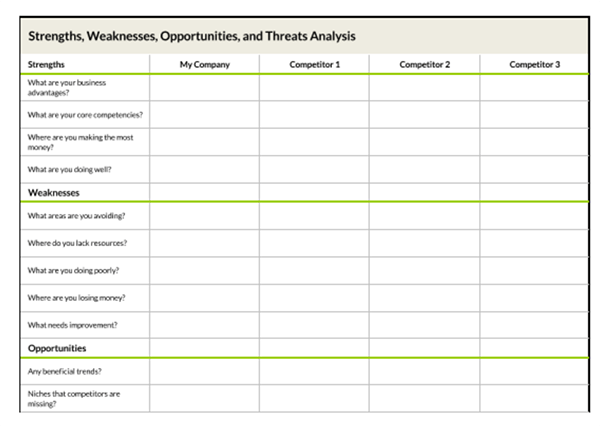
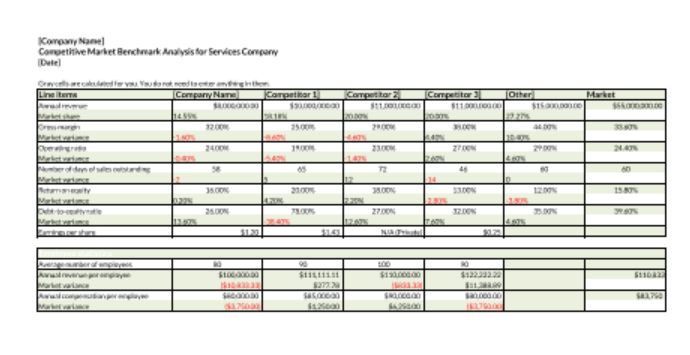
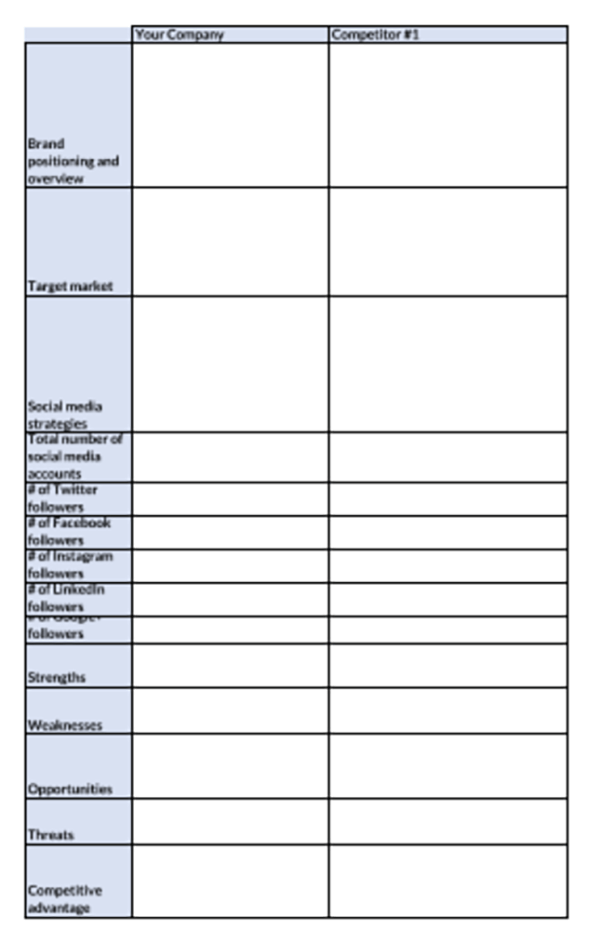
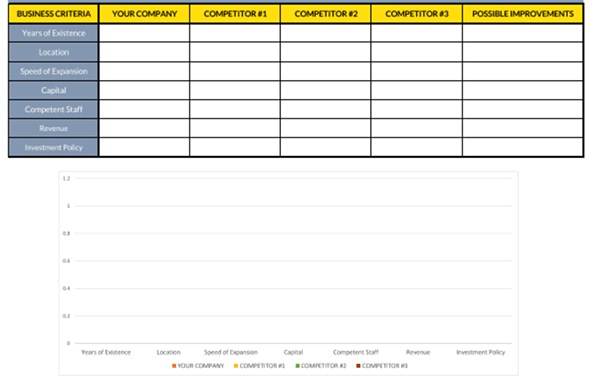
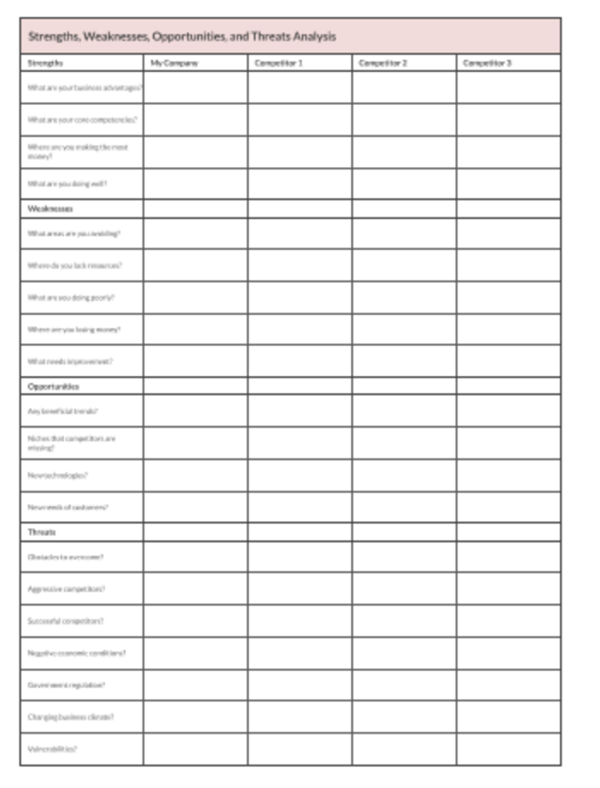
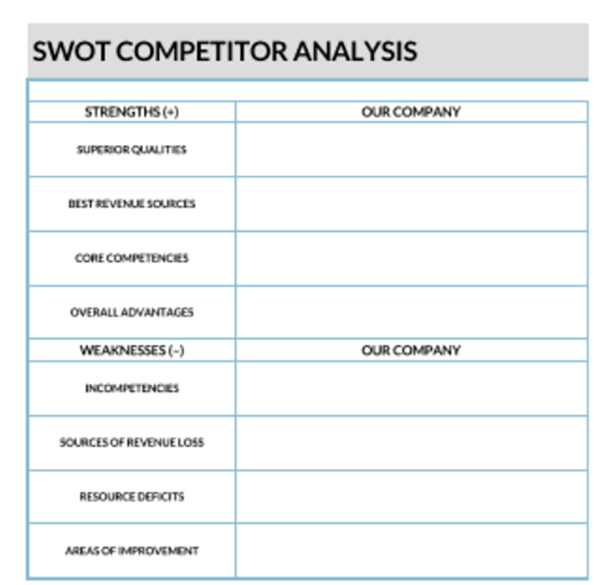
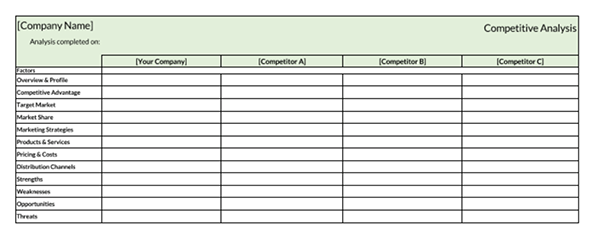
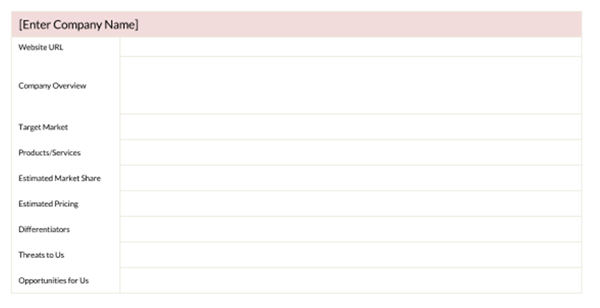
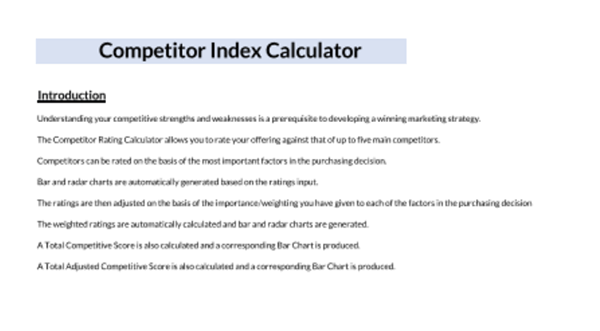
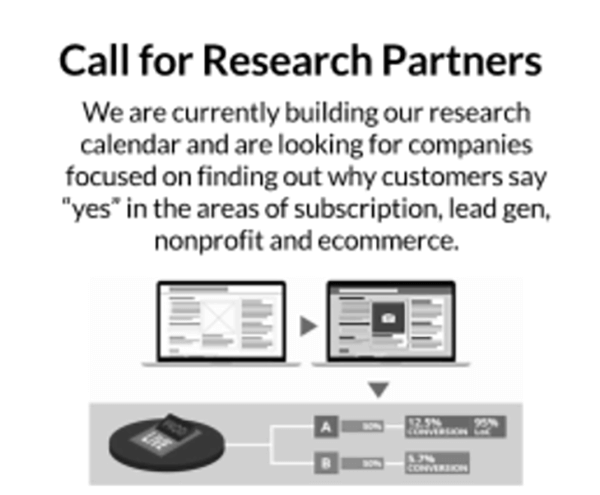
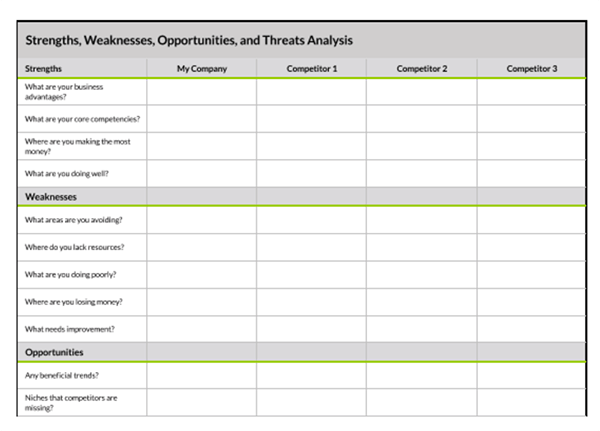
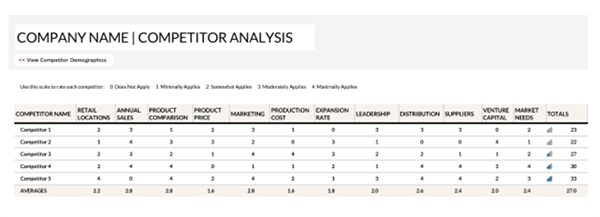
What Should You Include In It?
For an analysis to be beneficial to a business, it needs to be accurate, and the accuracy of an assessment will often be determined by the amount of details (considerations/factors) used.
A comprehensive analysis will often have the following components:
Company name
All the competitors being evaluated should be identified by name and listed in the template. They should also be categorized as either primary or tertiary.
Feature matrix
A list of all the features of the products or services of direct competitors should be input in a spreadsheet. A feature matrix forms the basis or criteria for comparison between company products and competitor products.
Product offerings
The analysis should include details about how each competitor’s products or services differ from each other and to those of the business in question. This will include factors such as price, features, potency, sustainability, design, quality, etc.
Market share percentage
The market share percentage of each competitor should be considered. This is important when it comes to determining the main competitors and key players in the specific industry. Large successful competitors can be used as benchmarks in analyzing areas of improvement.
Use the 80/20 rule. Competitors with a similar or close market share should take up 80% while 20% should higher-up competitors.
Price range
It should highlight how much each competitor charges for the same product and service. The quality and quantity of the products and services should also be identified.
Marketing and social media engagement
It should include the type of marketing strategies adopted by each competitor as well as social media engagements associated with each competitor. Marketing and social media engagement are significant contributors to sales, hence its inclusion.
Differentiators
The qualities that differentiate each competitor from the other and the business conducting the analysis are referred to as differentiators. The differentiators will usually be the selling points of the competitors.
Strengths
The strengths are the things that the competitors are doing right and have a positive impact. Customer feedback/reviews will usually help in identifying these strengths. Strengths are important in determining what a competitor is doing right so that it can be adopted or incorporated in the company as an improvement measure.
Weaknesses
Weaknesses represent areas where the competitors could be doing better. Weaknesses can also be identified from customer reviews. Weaknesses are necessary to assess as they represent where the competitor is lacking or unsatisfactory to customers and thus present an opportunity or niche that a company can fill.
Geography
The analysis should state where each competitor is located and their business model, whether brick-and-mortar, partially, or fully online. Geography influences how a company engages with its customers and presents different opportunities and challenges in running the business. Knowing a competitor’s geography helps in assessing these factors, which can greatly influence a company’s success.
Culture
Such an analysis should look into the brand and core values of the competitors. Culture also includes employee satisfaction and customer experience when interacting with the company.
Customer reviews
A conclusive analysis should consider customer reviews to identify the pros and cons of each competitor. An analysis of the 5-star review system should be done to identify the company’s position in customer satisfaction.
Pre-Considerations for Conducting Analysis
The analysis requires extensive research on competitors and the collection of pertinent data to facilitate the comparison between them and the business. The more detailed an analysis is, the more effective it will be.
Identifying competitors
An analysis would not be possible without competitors. A company, therefore, has to identify the different competitors that will be used as case studies to have an effective analysis.
The following aspects of competitors should be considered:
Kinds of competitors
There are different types of competitors within any industry. It is advisable to ensure that each type of competitor is represented in the analysis.
Below are the different kinds of competitors:
- Direct competitors: Direct competitors are businesses that sell similar products and services to the same target audience. Such type of competition will usually be within the same geographical area.
EXAMPLE
Nike and Adidas.
- Indirect competitors: Indirect competitors are businesses that offer products and services that can substitute what the business offers. Their products and services may not be similar to that of the business, but they satisfy the same customer need.
EXAMPLE
KFC and a local restaurant or Rolex and Seiko
- Tertiary competitors: Such competitors are businesses that either sell a product or service that can be linked to what your business offers or your target audience but satisfy a different customer need.
EXAMPLE
Toyota and Lamborghini.
Google and search engines
Google or any search engine of preference, research on competitors should be done before commencing it. Use this research to discover the different competitors within a field, industry leaders, and key information within the field. This will often involve the use of keywords, brand names, business specifications, product/service names, industry-specific jargon, or any other information that can lead to the discovery of different competitors.
Search engine ads
A search for ads on different search engines can also be conducted, and any ads that appear within the results can be followed up as potential competitors. Looking into ads broadens the scope of competitors discovered through search engine results pages (SERP) as some competitors may not rank well in the search engine due to ineffective SEO, or maybe they are new companies. Carry out multiple searches and review as many ads as possible.
Content tools
A business can use any tools that are used to analyze content and discover additional competitors. This will usually involve using industry terms that generate the most shared content related to what a company offers. Articles and blog posts can then be reviewed to identify any competitors mentioned within the content.
Prospects and customers
Competitors can be discovered through customer and prospective customer feedback. Customers can be asked about any new competitors approaching them, which can then be added to the list of competitors to be assessed.
Trade publications
Trade publications within an industry can be great sources for identifying competitors. It is therefore important to frequently review any digital or physical trade publications available within an industry.
Social media and forums
The use of social media and forums in social media has been integrated into the business world. With objective searches, it is easy to spot any competitors on social media using specific search functions such as hashtags, categories, and forums dedicated to the specific products and services within the social media.
Collecting data
Data is an essential part. The process of collecting data comes after the competitors have been identified from multiple sources. Data collection will often involve observing trends, patterns, uniqueness, statistics, etc., processes that can be done using various tools and software.
The following techniques can be used in data collection:
SEO analysis
SEO analysis involves the assessment of top-performing organic keywords, obtaining traffic reports as a result of SEO, search ranking, and target audience demographics. SEO analysis also helps in determining the competitors’ organic and paid search performance.
Keyword performance
Multiple aspects of keyword performance should be put into consideration. Information to obtain from keyword performance includes estimated monthly visits, key traffic sources, most profitable and popular keywords, the number of keywords used, the monthly budget used for marketing, and a backlinks analysis.
Social media performance
Data that can be obtained from the use of social media by competitors include frequency of posts and uploads, follower demographics, key influencer, most successful content, performance metrics, and most influential social media.
Email marketing
Email marketing can provide crucial information such as customer engagement, sending frequency, subject line tactics, formatting of emails, etc.
Content marketing performance
Analysis content marketing performance provides data such as top-performing content, backlinks monitoring, review of information used in contents, assesses social shares, and influence of content marketing on sales.
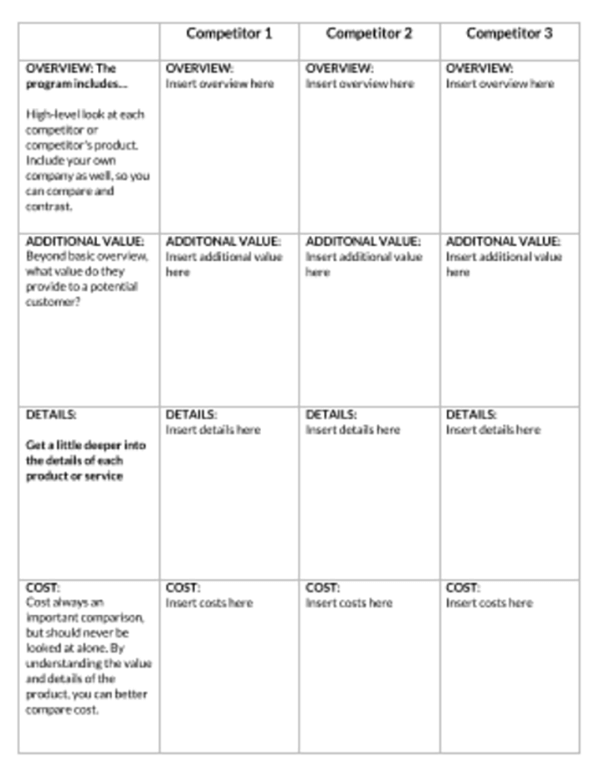
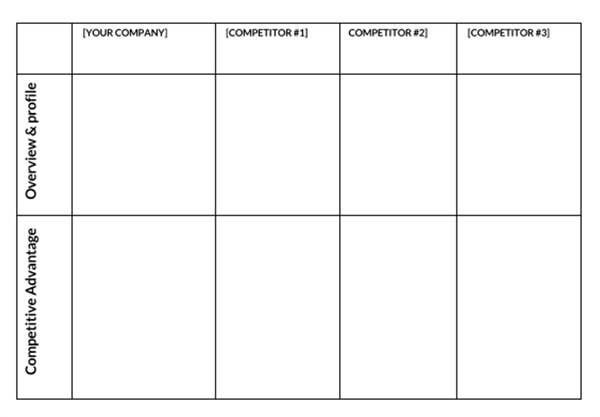
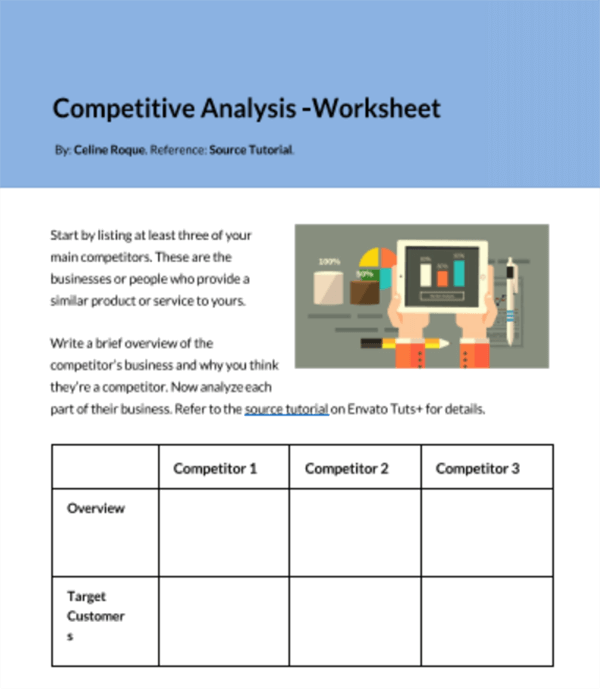
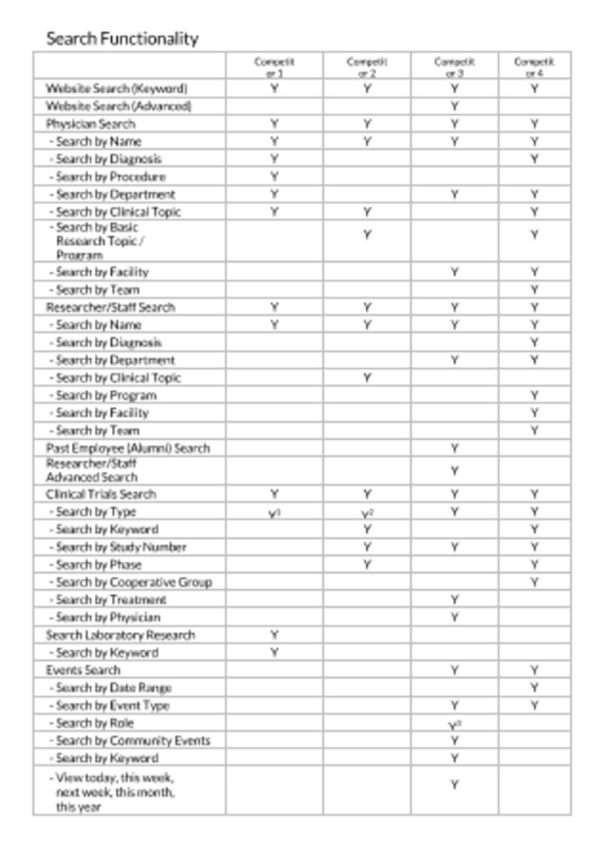
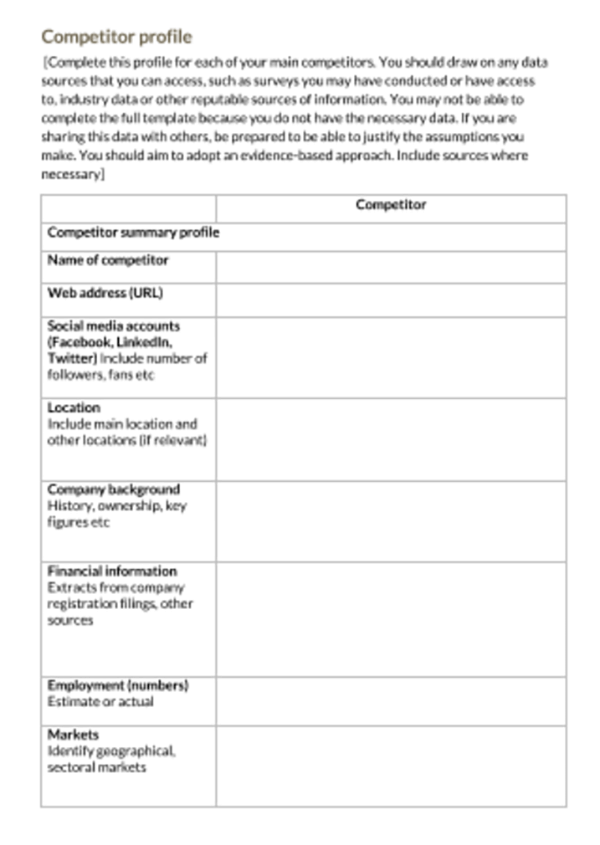
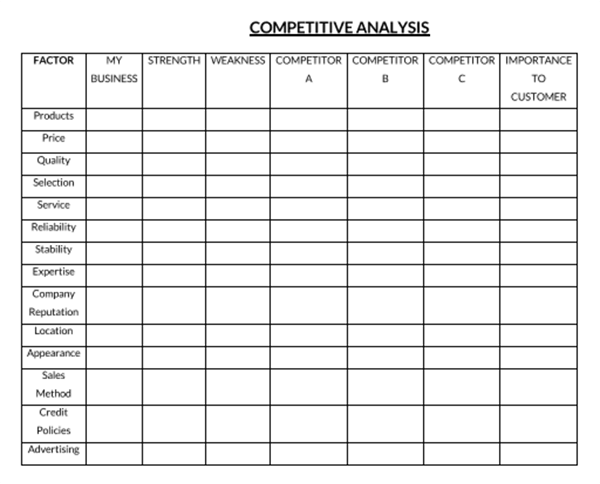
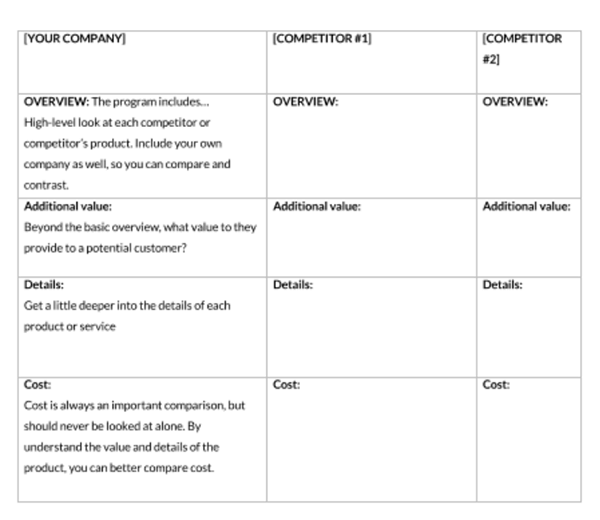
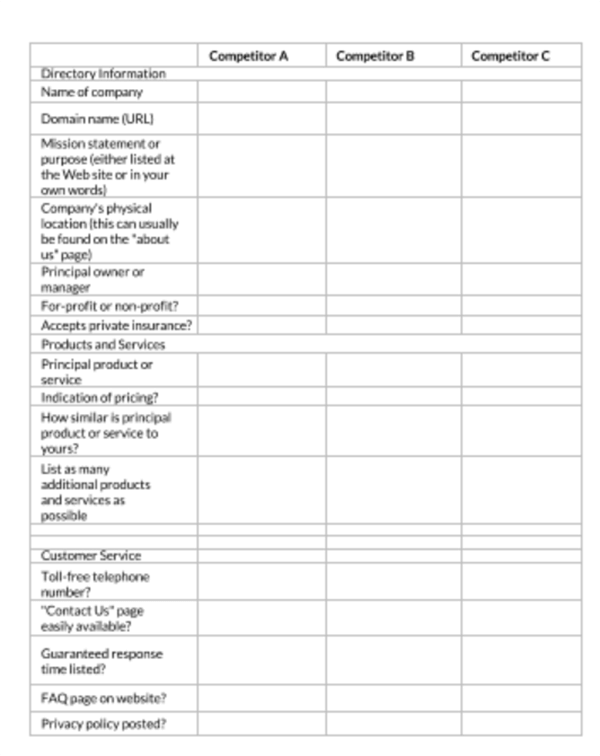
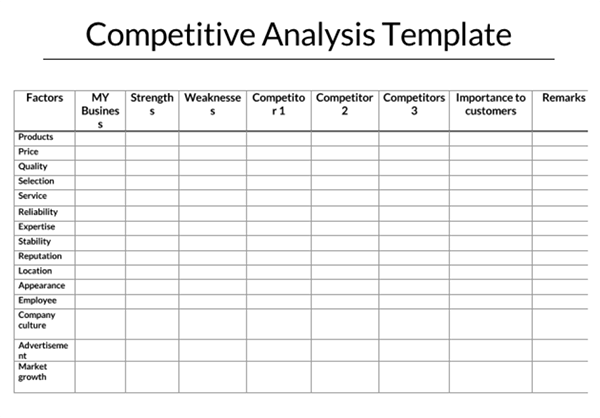
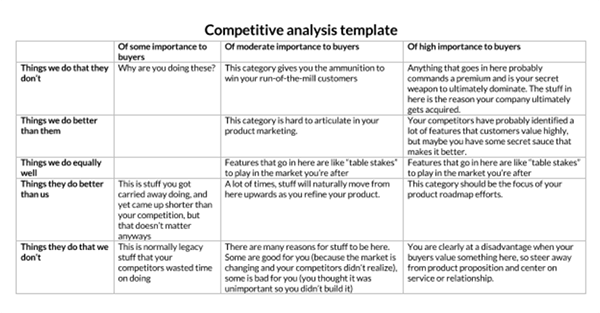
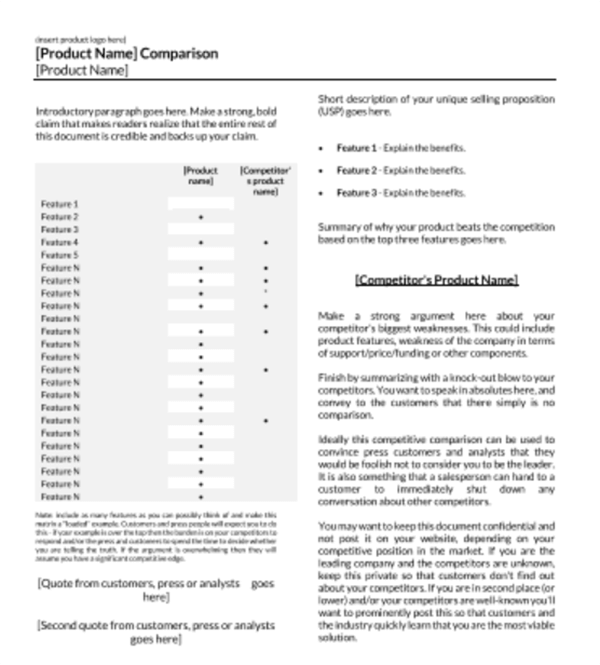
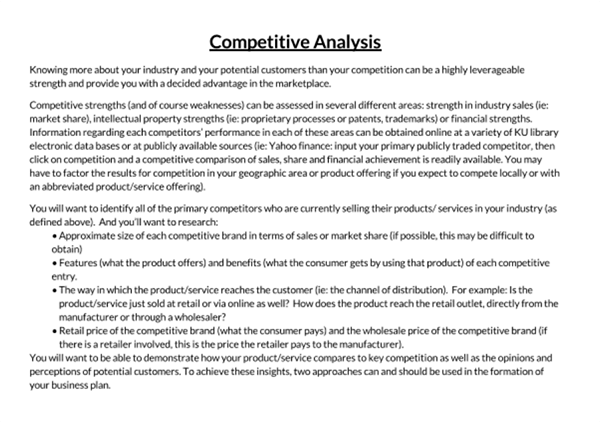
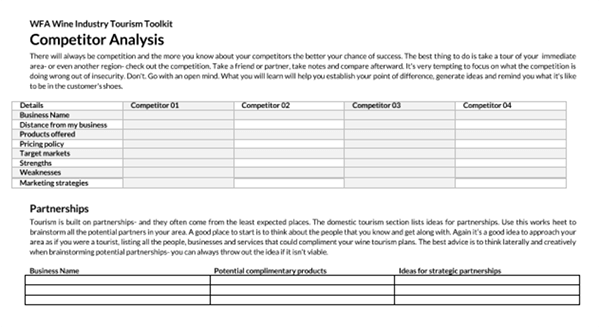
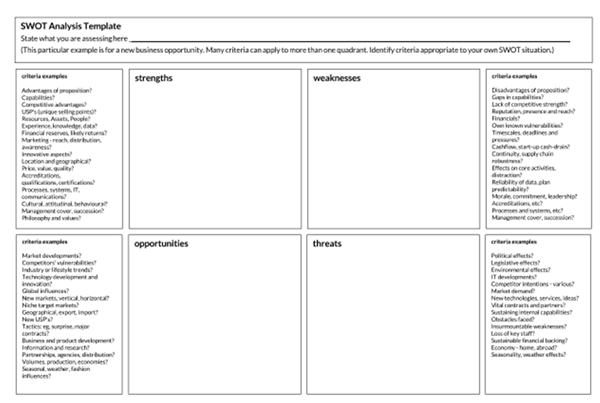
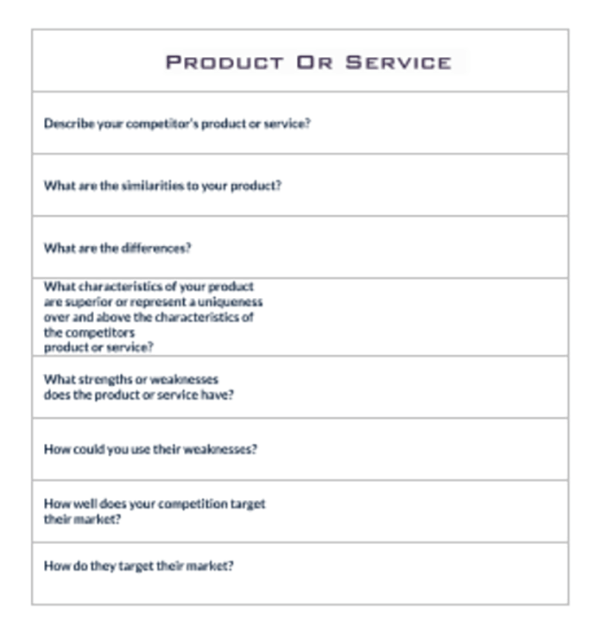
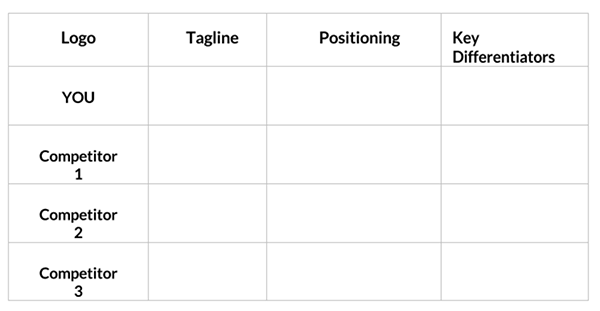
How to Effectively Conduct the Analysis for Your Business
It isn’t easy to narrow down on what to focus on because the analysis will usually be conducted based on what the business wants to accomplish.
The steps highlighted below can be followed:
Identify your competitors
The first step is identifying the different competitors that will be evaluated and compared. It is recommended to use at least 7-10 competitors. Select competitors with similar products/services, business models, target audiences, and different levels of experiences (high-end and low-end) for analysis.
Create a spreadsheet
Next, create a competitor matrix/grid, a table that outlines different criteria for the competitors to be characterized and compared. Use a spreadsheet and allocate each competitor a column or row. Then, on the other axis, input the different categories of competitor information you would like to assess. These categories can be increased as the analysis goes on.
Identify your competitors’ positioning
Afterward, determine how each competitor has positioned themselves in the market. This will involve obtaining some background information, profiling their target audience, and how they connect with them.
Determine when it was founded, why it was formed (vision and mission statement), how many employees they have and where they are located. A company’s position can also be defined by its market share, which is essential for sales and influence in a market. Look into their presence on social media, websites, events, press releases, interviews, and brand popularity.
Determine the 4P’s of each competitor
Once it is clear who they target their customers, delve into the 4P’s (product, price, promotion, and place) to determine how the competitors interact with their customers.
Determine what they are selling, how they market their product/service (billboards, email marketing, Google ads, social media, etc.), how much they charge (high-cost or low-cost, subscription or one-time purchases, discounts, etc.), and where they sell their products/services (brick-and-mortar or online, direct or third-party retailers).
Determine competitive advantage and offerings
Most businesses will always have a competitive advantage over other competitors. The analysis should be able to identify this advantage and what the competitors are offering compared to your business.
Some areas where companies get competitive advantages are quality, pricing, convenience, quantity, and reliability. Each company will usually have its own unique competitive advantage; note it down.
Determine customer experience and customer success
Once it is clear how each competitor fairs in terms of competitive advantage, look into how the competitors achieve customer satisfaction and compare it to your company’s experience. Customer experience and success is a huge contributor to creating trust and loyalty among customers.
EXAMPLE
If competitors offer shipping services, find out the shipping costs, means, and delivery time. Other tools used to improve customer experience are loyalty programs, giveaways, quick customer care services, discounts, etc.
Understand how your competitors market their products
The next step is determining the different marketing techniques used by competitors. This involves looking into how they reach customers.
EXAMPLE
Through blogs, whitepapers, eBooks, videos, webinars, podcasts, FAQs, articles, offers, visual content such as infographics, etc. Identify online and offline marketing strategies adopted by each competitor.
An effective approach to acquiring this information is by assuming the role of a customer by either purchasing the product/service, subscribing to the newsletters, following them on social media, etc.
Take note of your competition’s content strategy
Afterward, identify each competitor’s content strategy. Note the quantity and quality of marketing items they use, the frequency of distributing content, content engagement (likes, comments, and shares), and content virality (shares, retweets, hashtags, etc.). The quality of marketing content can be evaluated based on accuracy, spelling and grammar correctness, content substance, tone, legibility, and appeal.
Also, determine keywords in their content, dominant social media, backlinks, etc.
Learn what technology stack your competitors use
Next, identify the technology used by competitors to carry out different functions/operations, which consequently contributes to more efficient production and delivery of services. Although technology is an essential part of business and can have direct and indirect benefits, be thorough when evaluating technology adopted by competitors.
Technology can be in terms of software, equipment, machine, system or process, or intellectual property. Job listing and employee positions can give insight into the type of technology specialists being utilized in a company.
Perform a SWOT analysis
Lastly, perform a SWOT analysis to determine how your business fairs compared to its competitors. It should be conducted for each competitor and the business in question. Identify the strengths, weaknesses, threats, and opportunities that stem from each specified criterion (category of information).
Competitors’ strengths will usually represent threats, while weaknesses and threats indicate opportunities for your business. Conversely, a business’s strengths present a threat to competitors, while weaknesses and threats present opportunities. After the analysis, determine how the company is positioned compared to other players in the industry and identify areas of improvement.
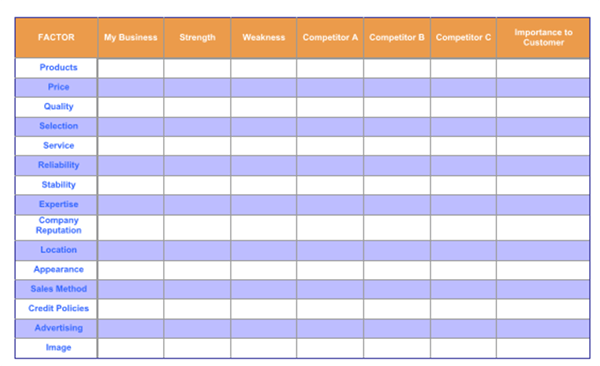
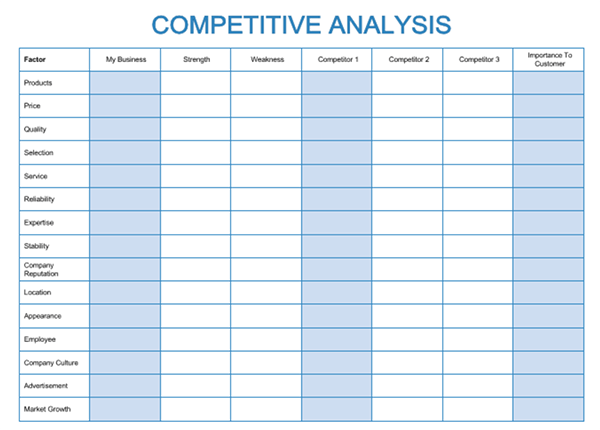
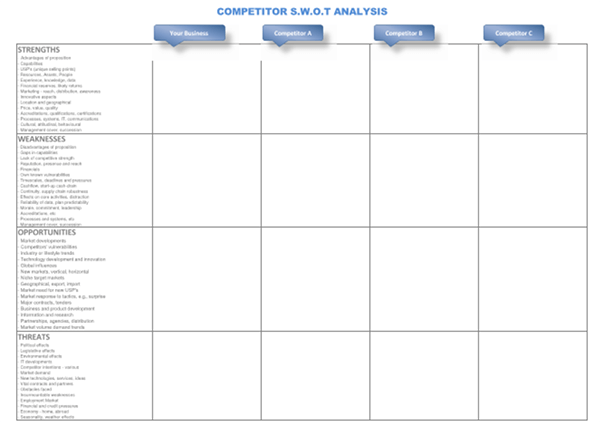
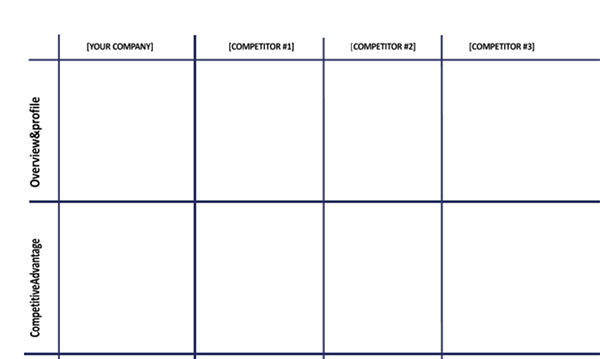
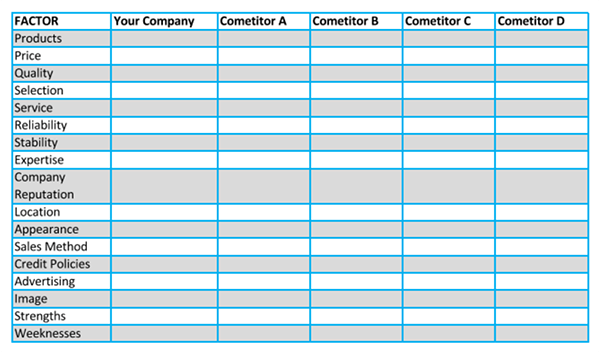
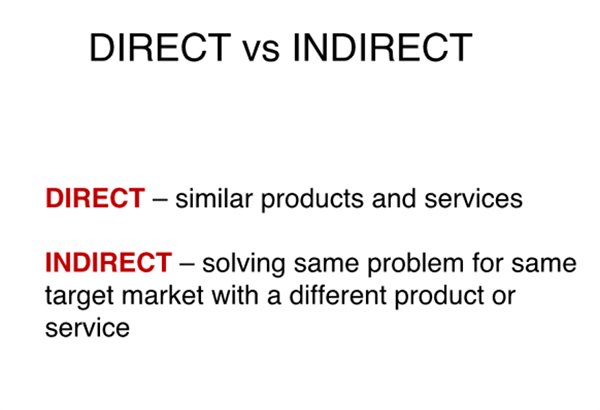
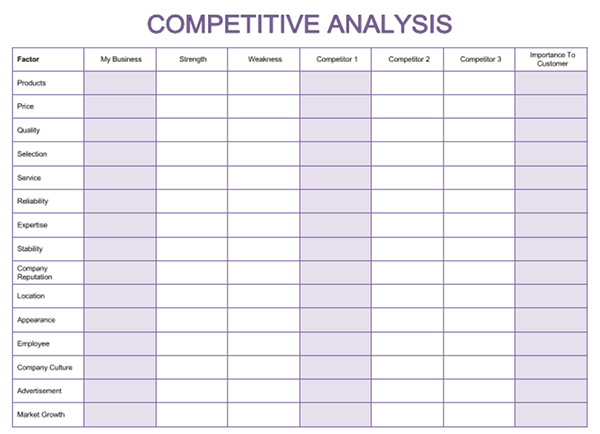
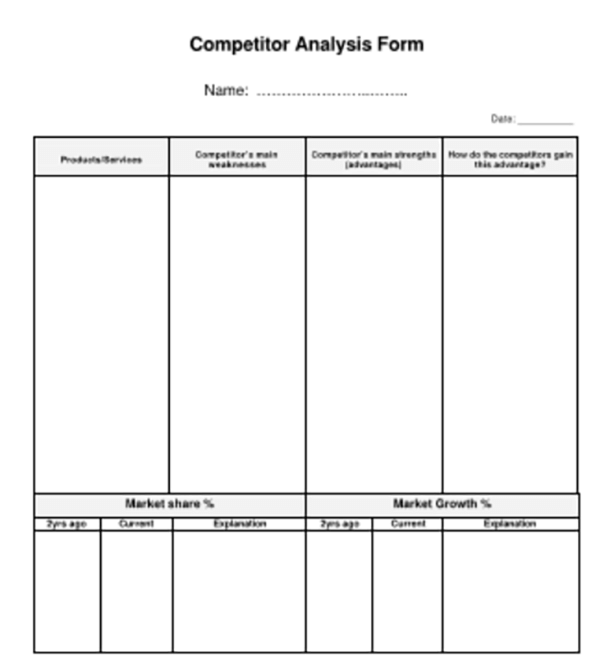
Pros and Cons
As much as it has its benefits, it is not short of several pitfalls. This section will discuss some of the pros and cons of undertaking the analysis for a business:
Pros
Here are several advantages:
- Identifies your product’s unique value proposition: It helps a business determine how well or badly positioned its product/service is compared to what its competitors offer. This information can be utilized to develop new marketing strategies and products/services and identify areas of improvement.
- Highlights your competitor’s strengths: Through the analysis, a company is able to identify areas in which competition is outperforming them and determine ways to catch and surpass.
- Identifies your competitor’s weaknesses: Analyzing a business’s competition helps identify areas where competitors are going wrong, which forms a majority of customer pains and, consequently, business opportunities.
- Provides you with a benchmark: Information obtained can be used as a benchmark for a company. Large, established, competitive corporations provide a benchmark for success for SMEs and start-ups. Start-up competition will usually present new ways or products to meet customer needs.
- Helps you learn through customer reviews: It is a learning opportunity for any business. Companies can obtain criticism and suggestions from customers within an industry by looking into customer reviews.
Cons
The cons of carrying out an analysis of a company’s competition include:
- It is not a one-and-done exercise: A competitive analysis is an ongoing process that requires constant review and updating for it to be used as a decision-making tool. Note that companies are always evolving and reinventing themselves so as to keep up with changes in the industry, technology, economy, etc. Therefore, you have to regularly revisit the analysis before making a decision based on its data.
- Confirmation bias is real: More often than not, assumptions have to be made at the start. No conclusions about the competitors should be made unless they are thoroughly tested using actual data. However, in some cases, this may happen therefore compromising the quality of the conclusions made by the analysis.
- Data without action is useless: The effectiveness of analysis is directly proportional to the implementation and effectiveness of any strategies made based on its results. If a well-informed strategy is not developed after the analysis, it consequently becomes useless.
- Working harder instead of smarter: A highly accurate analysis is the desired outcome. Conducting the analysis manually may compromise the quality of the end result due to human error. Therefore, using available tools is recommended to simplify the process and end up with an exceptional analysis.
- Starting without a direction: An analysis of competitors has to be objective. This means there must be a predetermined reason for undertaking it. Any such analysis without a clearly defined direction ends up taking longer, harder, and lower in quality.
- Not accounting for market timing: Time should be a vital consideration when analyzing competitors. As earlier mentioned, businesses are ever-evolving, and as a result, marketing at one point in time may not be effective at another time in the future. Therefore, evaluating the evolution of competitor marketing strategies can be more useful than evaluating an approach that had significant success at one point in time.
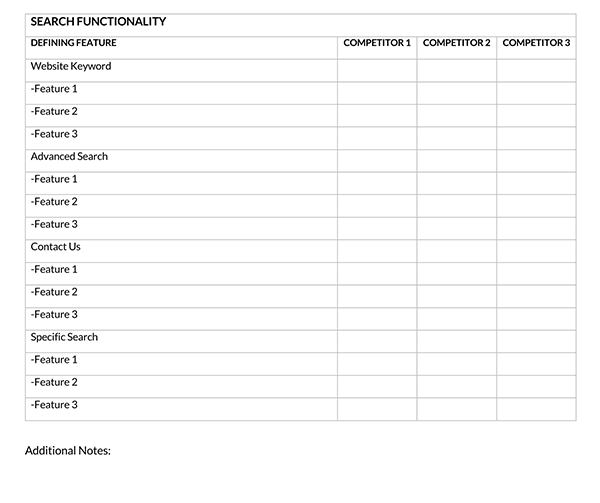
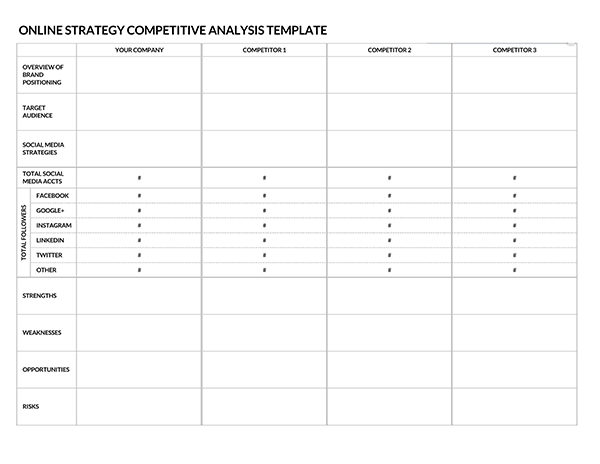
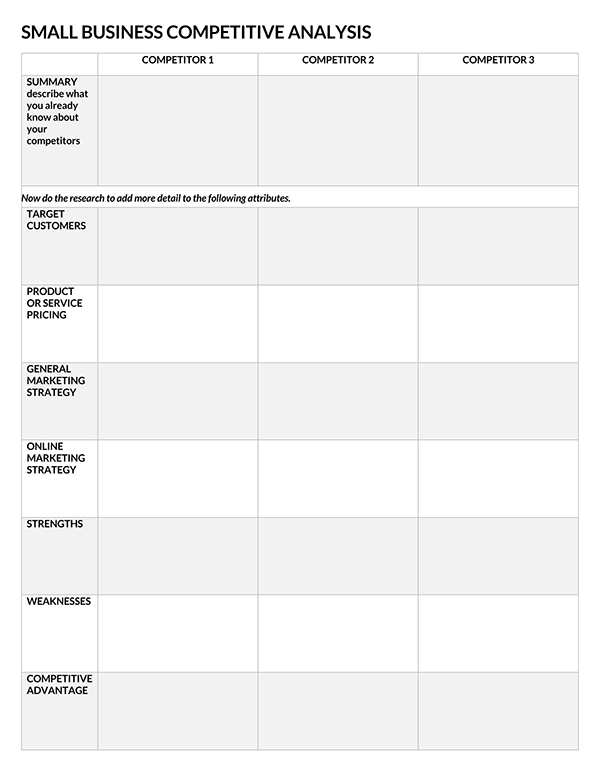

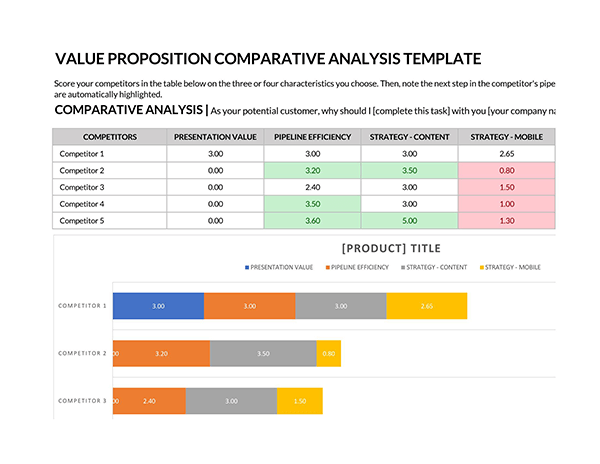
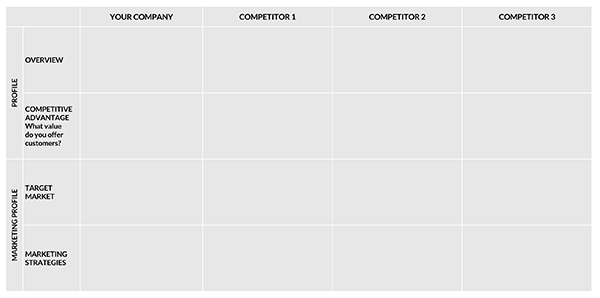
Frequently Asked Questions
Once the criteria for assessment have been established, it is essential to first evaluate your business by subjecting it to those criteria before delving into other competitors. Note down details as you would for the competitors.
There are different ways an e-commerce business can benefit from this analysis. Primarily, it helps businesses what makes them different and how other businesses in the same line of business are different. This way, the e-commerce business can determine areas to take advantage of, improve, and increase their market share and boost sales and revenue. In addition, an analysis of competition also helps a business make well-informed marketing strategies.
A SWOT analysis is not by definition, a competitive analysis; however, it is a technique used in competitive analysis to identify the strengths, weaknesses, opportunities, and threats of competitors and the business in question.




